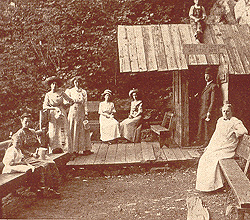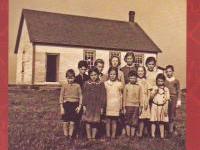Townships Heritage WebMagazine
Cemeteries of Austin
Cemetery Heritage in Quebec
 The publication, Cemetery Heritage in Quebec: A Handbook , is still available. The book, published by the Quebec Anglophone Heritage Network in 2008, and written by Matthew Farfan, project leader of QAHN's Cemetery Heritage Inventory and Restoration Initiative (CHIRI), is available in softcover format.
The publication, Cemetery Heritage in Quebec: A Handbook , is still available. The book, published by the Quebec Anglophone Heritage Network in 2008, and written by Matthew Farfan, project leader of QAHN's Cemetery Heritage Inventory and Restoration Initiative (CHIRI), is available in softcover format.
Days to Remember: One-room Schoolhouses in the Eastern Townships of Quebec
Missisquoi’s Mercantile Past: As Seen through Consumer Goods and Ledgers at the Missisquoi Museum
Business account books or ledgers from the 19th and early twentieth centuries are a valuable resource for the study of rural history. Historians have used account books to reveal their subjects’ community through the markets they operated in, the people they dealt with, and the goods they produced and consumed. The time that went into creating these ledgers reveals the importance of the daily relationships they recorded.
Potton Springs
 Bâti en 1875, le Potton Springs Hotel et ses célèbres sources sulfureuses attireront des milliers de visiteurs en provenance de l’est de l’Amérique du Nord. Les curistes arrivaient par train – le Missisquoi and Black Rivers Valley Railway qui deviendra ensuite l’Orford Mountain Railway et, finalement, le Canadien Pacifique.
Bâti en 1875, le Potton Springs Hotel et ses célèbres sources sulfureuses attireront des milliers de visiteurs en provenance de l’est de l’Amérique du Nord. Les curistes arrivaient par train – le Missisquoi and Black Rivers Valley Railway qui deviendra ensuite l’Orford Mountain Railway et, finalement, le Canadien Pacifique.
Une nouvelle vie : le peuplement des Cantons de l’Est
En 1783, la fin de la Révolution américaine in 1783 apportera de nombreux changements au Québec. Le Traité de Paris négocié entre les États-Unis et la Grande-Bretagne établit la frontière de la République nouvellement formée avec le Québec; au sud, ce sera le 45ème parallèle, en direction est, l’ensemble des terres. En plus de cette entente frontalière précise, près de 10 000 personnes choisiront d’immigrer au Canada, marquant ainsi leur loyauté envers la Couronne Britannique.
New Book Looks at Historic Townships Homes
Anyone with more than a passing interest in the architecture and history of the Eastern Townships, in particular that part of the Townships bordering the U.S., will be interested to know that a new book has just been published on a type of architecture that, apart from the neighbouring states of New England, is quite unique to this part of Quebec.
Les travaux et les jours
«La femme est un peu comme une esclave dans ce pays»
Journal intime de Anne Langton, 1839
The Rebellion Comes to Missisquoi
The rise of the Patriote movement in the 1820s and 1830s was a crucial turning point in Quebec’s history. For Louis Joseph Papineau, the eloquent spokesman of the Parti Canadien who led the resistance to the unification of the Canadas, Lower Canada was a distinct and important territory to be preserved as a French and Roman Catholic home for its inhabitants.
Pagination
- Page précédente
- Page 98
- Page suivante


